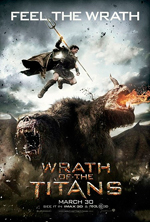
Wrath of the Titans

 – for intense sequences of fantasy violence and action.
– for intense sequences of fantasy violence and action.
Director: Jonathan Liebesman
Starring: Sam Worthington, Liam Neeson, Ralph Fiennes, Rosamund Pike, Édgar Ramírez, Toby Kebbell, Bill Nighy
Running Time: 1 hour, 39 minutes
Theatrical Release Date: March 30, 2012
Official Site
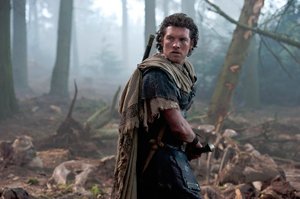
Plot Summary
A decade after his heroic defeat of the monstrous Kraken, Perseus-the demigod son of Zeus-is attempting to live a quieter life as a village fisherman and the sole parent to his 10-year old son, Helius. Meanwhile, a struggle for supremacy rages between the gods and the Titans. Dangerously weakened by humanity’s lack of devotion, the gods are losing control of the imprisoned Titans and their ferocious leader, Kronos, father of the long-ruling brothers Zeus, Hades and Poseidon. The triumvirate had overthrown their powerful father long ago, leaving him to rot in the gloomy abyss of Tartarus, a dungeon that lies deep within the cavernous underworld. Perseus cannot ignore his true calling when Hades, along with Zeus’ godly son, Ares (Edgar Ramírez), switch loyalty and make a deal with Kronos to capture Zeus. The Titans’ strength grows stronger as Zeus’ remaining godly powers are siphoned…
(from Warner Bros. Pictures)
Film Review
In 2010, Warner Bros. resurrected a potential franchise when they remade the 1980s film, Clash of the Titans. The original was a campy take on Greek mythology that represented the iconic monster movies of the time and before it. The remake, starring rising star Sam Worthington (Avatar), received mixed reviews, but provided a much bigger-scaled take on the original. It was more action intensive, had a driving score, and boasted big special effects. I did enjoy it the first time I saw it, but, admittedly, with each consecutive viewing, there were aspects of the film that continued to grate on my nerves. For 2012, Warner Bros releases the franchise’s first sequel, Wrath of the Titans, the first original follow-up in this story.
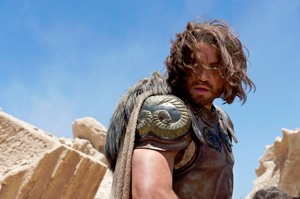
To properly weigh in Wrath of the Titans, I feel the need to address some of the things I’ve grown to really dislike about the 2010 remake. For starters, while there were some great likeable characters that accompanied Perseus on his quest (and, of course, died–some much too quickly), the film’s lead was a broody, moody whiner. Worthington played Perseus rather dry, and when he wasn’t dry, he was overacting a bit and complaining about not wanting to harness the godly traits of his demigod makeup, insisting on conquering the titans as a man. In addition, there is one particular character in the 2010 remake that gets worse with each viewing: a religious nutjob with an irritating voice and an obnoxious on-screen presence. This little wacko killed each scene he weaseled through and has gone on to become one of my most detested movie characters of all time (yes, folks, I’d even take Jar Jar Binks over this pipsqueak). Now when I watch the 2010 Clash of the Titans, I absolutely must fast forward through his scenes. Lastly, Ralph Fiennes played Hades with such overly dramatic and exaggerated camp that it’s a miracle he ever agreed to reprising the role. the movie was uneven, unbalanced, and over-the-top. The soundtrack was just as uneven as it was big and heroic at times, but then would seem overpowering at other times. Composer Ramin Djawadi even worked in some Iron Man-esque (he composed that film too) guitar riffs which wrenched the viewer out of the time period the film was intended to exist in. All of this, not to mention the bizarrely out of place Djinn creatures and the corny and grotesque Calibos, just continues to damper that film for me.
I revisited Clash before entering into Wrath and I’m glad I did. Wrath opens with an explanation for Gemma Arterton’s character IO not returning, and we learn that she and Perseus had had a son together, Helius, who is now ten years old. Once again, Perseus is a man struggling with loss, but he seems to have come to grips with who he is. Right off the bat when his father Zeus comes to visit him, it seems as though Perseus has softened a bit; apparently marriage and parenthood had been good for him. With so much time having passed between the story of the first film and this one, the gods have lost their power considerably and are on the verge of having their personal battles touchdown on earth once again. Director Jonathan Liebesman takes the reins from Clash‘s Louis Leterrier, bringing an entirely different style to the film. Sometimes it feels bigger, sometimes it feels immensely smaller, and other times it feels like an indie film. After also revisiting the Bourne trilogy, which had used a lot of handheld camera work in those sequels, I particularly noticed this about Wrath of the Titans. Instead of your usual cinematic approach, Liebsman gives Wrath a more gritty look. Given that the underworld is literally beginning to spill out onto earth, the creatures attacking our heroes are dark and monstrous. While the sweeping landscapes and locations are used once again, they’re more desolate; you don’t really get much bright and sandy scenery (Not that Clash was all bright and bubbly, but even their time in a forest in that film was relatively sunny. A prolonged sequence in the forest in Wrath is dim and ominous).
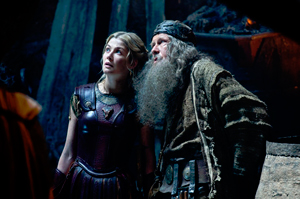
Directorial changes were not the only alterations made from Clash to Wrath. Andromeda has been recast from the young, dark-haired Alexa Davalos to the older, more mature blonde-haired Rosamund Pike. It’s a pretty stark contrast between the two actresses, but I’ve enjoyed Pike’s work before, so I thought she was a fine addition to the cast. Liam Neeson and Ralph Fiennes reprise their roles as Zeus and Hades, respectively, while only one other god–out of the many seen in Clash–makes a return, Danny Houston as Poseidon. The war of the gods has consumed many lives and we don’t even see into Olympus this time around. We are, however, introduced to an entirely new god in the series, another son of Zeus, Ares. Édgar Ramírez, who may be most recognized for his role as an asset chasing Jason Bourne in The Bourne Ultimatum, serves as the latest big guy to want to take Perseus down. He’s a decent addition to the gang, and he gets some good screen time with Worthington. Rounding out the cast is Bill Nighy as Hephaestus, a god who has lost his mind due to being in exhile for a long time (the owl from the original 80s film makes another cameo here and it’s fantastic). Nighy is a terrific actor and, although he seems underused here, he lights up the screen during his short time in Wrath.
The story of Wrath of the Titans allows for a little more human element and emotion than in Clash, but really, Liebsman and company are just out to make a big action/adventure film. Because of that, the film doesn’t stick to driving the plot forward too much before bursting into the next big action scene or visual spectacle. Still, although Worthington is only a little less dry as Perseus here, there’s a greater sensitivity in the relationships in this movie that Clash sorely lacked. Andromeda isn’t given much to do other than shout at soldiers and look pretty, but she still does slightly more than pose as attempted Kraken bait like in Clash. Youngster John Bell plays Worthington’s son, Helius, but instead of turning this series into some kind of Mummy Returns travesty by writing the main characters that fans liked about the first film into the background to bring some new, annoying kid actor to the foreground, Liebsman does a wonderful job in, not only casting Bell, but using him sparingly. Bell appears briefly at the start of the film and isn’t carried throughout the entire movie. When he reappears during the film’s climax, it makes sense and is done very well. It also draws some nice parallels between Perseus’ father/son relationship with Zeus. Wrath of the Titans skims the surface of emotion and substance and doesn’t go the distance like it could have, but I found it more satisfying than the 2010 remake. And finally, Toby Kebbell (Prince of Persia / War Horse), who plays Agenor is a nice added comic relief, but he feels a somewhat under-developed. Once he was introduced as Poseidon’s son and brought along for the journey, I was expecting much more from his character than was delivered, although I also can’t exactly say that he was entirely wasted either.
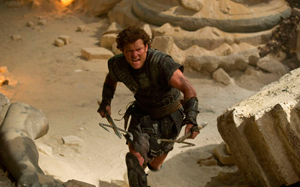
This sequel doesn’t come through entirely scott free either, however. A promising sequence that reveals the monsters of the menacing scene to be horrible CG cyclops giants is cheesier than I imagine the filmmakers hoped it would be, while some of the editing throughout the movie is a bit problematic. Some of the shaky cam work does more harm than good, while other times, it plays up the confusion that the characters are experiencing. The latter works best when Perseus is attacked by an unseen creature and the frantic editing adds to the tension of the moment. Other times, like when Ares starts taking out soldiers one by one, it makes the film feel like it’s skipping, leaving potentially important moments on the cutting room floor, forsaking clarity. The film’s score is also just average. It works well, for the most part, with the movie, but it’s not memorable at all, and apart from the film it feels amateurish. And lastly, the climactic finale suffers some from the quick cuts and editing, making some of the action hard to clarify and maybe a little confusing (or, even worse, it doesn’t ahere to the continuity.
The content for Wrath of the Titans is about on par with Clash of the Titans, if not maybe a little tamer. The creatures are less gruesome, but there are plenty of violent action scenes and characters getting bloodied up. Near the beginning, when Perseus has a run-in with a two-headed beast, he comes away with a couple nasty wounds. We see a woman sewing up a gash on his shoulder (in a dimly lit room), and then we see a bigger gash on his back a few moments later (before the scene cuts). Otherwise, we see Perseus with varying amounts of blood on his head throughout the fight scenes, and there’s a sequence where a sword is dug into a cyclop’s hand (it was hard to tell, but it may have gone through it, too). There is plenty of other degrees of violence and killing, but most of it is shown in quick cuts or implied with minimal amounts of blood shown.
Wrath of the Titans is one of the rare instances where the sequel is better than its predecessor (which, in this case, is also a remake). However, if you didn’t like the 2010 take on Clash of the Titans, you may not like Wrath either, or you’ll only find it slightly better. Wrath of the Titans makes no bones about being just a fun action/adventure popcorn flick, so unless you’re cool receiving exactly that, then you’d best pass on this sequel entirely.
– John DiBiase, (reviewed: 2/5/12)
Parental Guide: Content Summary
![]() Sex/Nudity: None. Hephaestus makes a fleeting comment about Poseidon having taught him how to seduce a mermaid.
Sex/Nudity: None. Hephaestus makes a fleeting comment about Poseidon having taught him how to seduce a mermaid.
![]() Vulgarity/Language: 2 “h*ll”
Vulgarity/Language: 2 “h*ll”
![]() Alcohol/Drugs: None.
Alcohol/Drugs: None.
![]() Blood/Gore: Perseus has a bloody wound on his shoulder after a fight and we briefly see a woman sewing it up (in a dimly lit room). He then turns over and we briefly see a nasty gash on his back; We see a man with part of his face burned who slowly turn to ash and falls apart (we see this happen twice more later on to two other characters); Zeus has a scabby cut across his face; Agenor has some dried blood running down his arm; Perseus has some blood on his face during some fight scenes; Perseus has blood on his fingers as he holds what looks like a blood-soaked rag; We briefly see some bloody linens hanging in an infirmary; Perseus has dried blood streaks on his forehead and the side of his head; A person has two bloody spots on the back of their clothing after a spear is thrown into their back (and then removed); We see a dagger sticking out of a person’s chest with blood running all the way down their clothes.
Blood/Gore: Perseus has a bloody wound on his shoulder after a fight and we briefly see a woman sewing it up (in a dimly lit room). He then turns over and we briefly see a nasty gash on his back; We see a man with part of his face burned who slowly turn to ash and falls apart (we see this happen twice more later on to two other characters); Zeus has a scabby cut across his face; Agenor has some dried blood running down his arm; Perseus has some blood on his face during some fight scenes; Perseus has blood on his fingers as he holds what looks like a blood-soaked rag; We briefly see some bloody linens hanging in an infirmary; Perseus has dried blood streaks on his forehead and the side of his head; A person has two bloody spots on the back of their clothing after a spear is thrown into their back (and then removed); We see a dagger sticking out of a person’s chest with blood running all the way down their clothes.
![]() Violence: Lots of action/adventure violence. Some of this includes:
Violence: Lots of action/adventure violence. Some of this includes:
A two-headed monster that spits a flammable liquid from one head and ignites it with the other head tears through a town, killing people. Perseus ends up spearing one head to the ground, causing the creature to inadvertently set itself on fire; A god pummels a few other gods while little fire demons shoot fire at them, knocking one down, mortally wounding them; A god is captured and chained up. We see them punched in the head while tied up, unable to defend themselves; A group of cyclops giants attack some soldiers, killing some. Perseus pushes his sword into the palm of one of their hands and the giant puts its other hand on top. It’s hard to tell, but it’s possible that the sword went through both hands; Ares beats up a bunch of people, stabbing several to death; A minotaur attacks Perseus and the two fight before he breaks the creature’s horns and strangles it to death; A man throws a spear/staff of sorts and it impales a person’s back; Agenor slaps Perseus; Fire demons emerge, wielding multiple swords in their multiple arms and proceed to slice and kill many soldiers; A man and a god fight to the death, which is pretty brutal at times. One of them is run head-first through several pillars. It ends with one of the characters being stabbed twice and choked; A huge fire monster throws lava and fire and demolishes buildings and causes waves of wind and power to level things. It also causes a character to be thrown and die as a result soon after; and other action violence.
